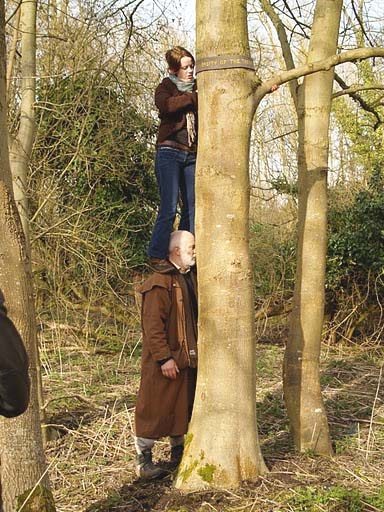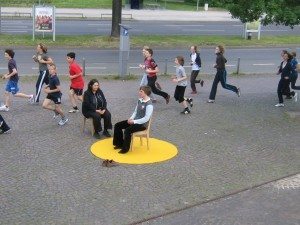Location: Oxford, England
University of the Trees (www.universityofthetrees.org) is one of the current long-term social sculpture projects linked to the new Social Sculpture Association and to the Social Sculpture Research Unit(SSRU) at Oxford Brookes. The SSRU has a focus on doctoral research, graduate programmes, research projects and research forums, whilst the new Social Sculpture Association, based in London and Berlin, develops ecological-cultural action processes and projects – that do not sit easily in institutions.
Like Exchange Values (www.exchange-values.org), Ort des Treffens (www.ortdestreffens.de) and other projects initiated by myself and other members of these collectives – University of the Trees is environmental in an expanded sense, which is gaining increasing currency. This expanded understanding of environment is akin to Beuys’ ‘expanded conception of art’, which is something quite different from Krauss’ notion of ‘art in the expanded field’, of art outside the gallery and museum walls. This expanded conception of environment, and of art, is transdisciplinary and multidimensional.
When Joseph Beuys said he was not interested in ‘spinach ecology’ and that ‘it is the human soul that needs saving’- statements which have been widely misunderstood, often by his close associates – Beuys was alluding to an expanded understanding of ecology that is intimately connected to and depends on a widened and deepened human consciousness.
Not questioning the need for the ceaseless tree planting that Joseph Beuys, Wangari Maathai and many others have implored us all to do, the members of this social sculpture network, exploring an expanded conception of art and of environment, are however equally committed to ‘instruments of consciousness’, ‘new organs of perception’ and foregrounding the connection between inner and outer work. This aligns closely with the view of E.M.Schumacher – one of the early sustainability thinkers – that we need a ‘culture of the inner human being’ if we are to evolve a sustainable society.
The annual summer programme in Weimar –From Goethe and Schiller, through the Bauhaus to Social Sculpture,led by Hildegard Kurt and myself, is informed by a similar perspective and like University of the Trees and other projects we have initiated, it is concerned with exploring the relationship between culture and sustainability and moving beyond the technical, literal emphasis that most sustainability work prioritises. Central to all these social sculpture programmes and projects are what another of my SSRU collaborators, Wolfgang Zumdick, describes as ‘the poetic continent’. In the ATLAS, a co-authored philosophical workbook, linked to the Ort des Treffens project that I initiated in Germany in 2008, we explore the connection between inner and outer work, in our work toward an ecologically just and humane society.
Drawing on Goethe’s work on ‘new organs of perception’ and how this has been taken up by scientists like Arthur Zajonc and Henri Bortoft, as well as my own reformulation of the aesthetic that connects it to our ‘ability-to-respond’, and to Schiller’s radical proposals in the ‘Letters on the Aesthetic Education of the Human Being’, the members of this collective are committed to the view ‘there is only one field of transformation – and no one is outside’. With this statement, and working with questions as invisible, but formative forces, I have been setting up ‘Substance Groups’ and doing ‘thought work’ social sculpture processes in various contexts. Working with a specially designed ‘Thought Wedges’ participants are brought into an experience and an awareness of the subtle material that we all have access to, and with which we shape both our own lives and the world around us. One of these processes took place in a symposium in London, in 2009, which brought 150 Nobel Laureates and heads of companies together at St. James’ Palace -to discuss the climate crisis. In July this year a similar social sculpture process is being developed for the Institute for Social Banking summer school in Florence -where people from ethical banking and new economics initiatives will meet from around the world.
The emphasis on sensuous, experiential knowing in the field of social sculpture is also the subject of a new book project, co-authored by Hildegard Kurt and myself entitled: Making the Secrets Productive: Aesthetic Education for Sustainability. This book will not only highlight the links to other fields and practitioners to whom we are indebted -from the early ecofeminists and archetypal psychologists, to people working in ecopsychology and organisational learning – but will also present methodologies and strategies for transformative, imaginal work that are as significant to all our pedagogical work as to our projects and process.
In this sense we make little differentiation between our teaching and our practice. All the work we do is concerned with the exploring the links between imagination and transformation and how responsibility can shift from being a moral imperative to becoming an ability-to-respond. Suzi Gablik’s wonderful phrase ‘connective aesthetics’ resonates with all the work we do, for which we have coined the term ‘connective practices’.
If you are interested in our social sculpture work please look at our websites: www.social-sculpture.org
www.universityofthetrees.org.
Regarding the Weimar summer programme see:
www.weimar-summer-courses.de
Shelley Sacks – Social Sculpture practitioner
Principal Lecturer / Reader in Art
Director – Social Sculpture Research Unit
Oxford Brookes University
Headington Hill Campus
Headington, Oxford OX3 0BP
WEAD MAGAZINE ISSUE No. 1, CREATING CONNECTIONS
Published August 2010



